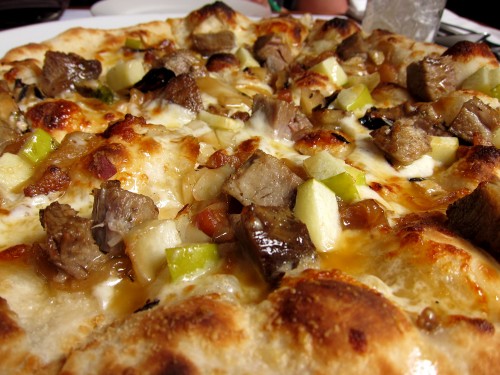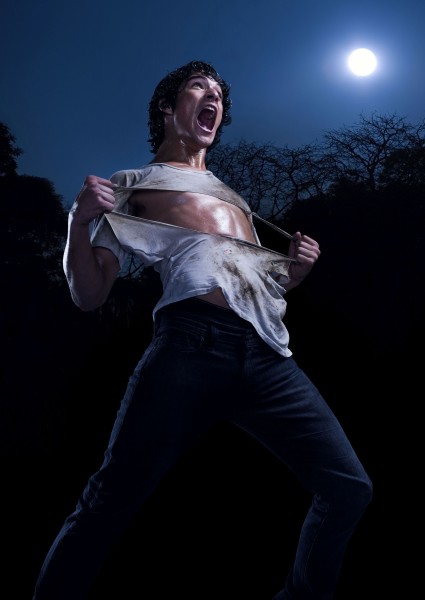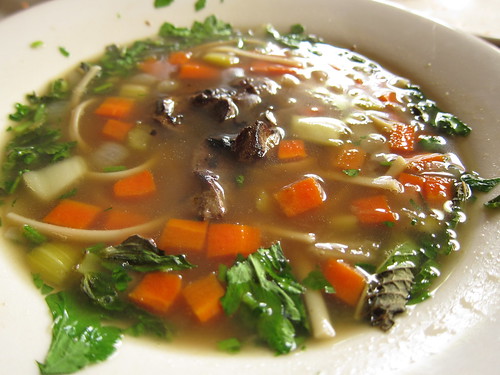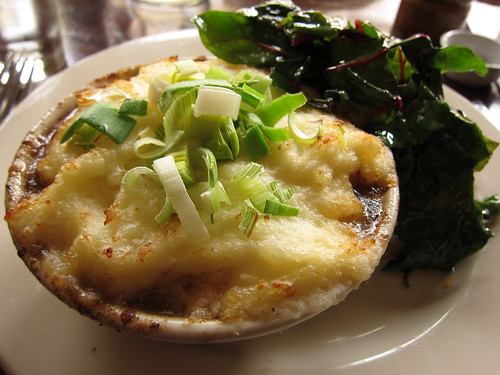[This is crossposted from Talesblog.com — my annual post about where to enjoy fine food and drink while at Tales of the Cocktail in New Orleans.]
“Oh yeah, we’re going to New Orleans for Tales this year! I hear the food’s good!” (Well … yeah.)
I thought it only proper to continue the four-year series of posts I’ve been writing about places to eat and drink in my hometown as you descend upon it for Tales, but first a few logistical notes …
In case you haven’t noticed the weather forecast, scattered thunderstorms began in New Orleans last week and are expected to continue through the beginning of Tales. I’ve seen forecasts that show daily thunderstorms the entire week, but the local forecast on nola.com shows good weather Thursday through Sunday. As one always does when one comes to New Orleans, though, bring your umbrella and don’t lose it, ’cause you’re likely to need it.
Also there’s apparently still some construction going on around the Carousel Bar in the Monteleone Hotel, drinking central for many folks staying in the hotel for Tales. Not to worry, the Carousel Bar itself is open but as of this weekend the piano bar behind it was not, as it’s under construction; it’s being joined with part of the restaurant space behind it to create a larger bar space. They’ll be opening up windows on the street-side of the new space, which will be terrific. According to Diana Schwam of Frommers.com, one of our esteemed local advisers, apparently there were windows when the building was first built, which makes sense; now they are going through 3-foot walls to re-use them. I love the reclamation of history! The plan was for the project to be finished before Tales, so we’ll see what happens by Wednesday.
Now, eating and drinking! First of all, my previous advice stands. If you’re a newbie to Tales or a veteran who needs a refresher course, check out my posts from 2010, 2009 and 2008. All the advice in the previous post from Steve and Paul is good too. (And may I add … Cochon, Cochon, Cochon! Do it!) Shall I tempt you a bit more? Here are a few scenes from my most recent meal at Cochon, a couple of months ago:

Some crispy-fried pork belly, perhaps?

Fried rabbit livers with pepper jelly? (They also do the dish with chicken livers.)

Braised pork cheeks with fava beans and spoonbread? Yeah, like they said, get thee to Cochon.
Don’t forget Cochon Butcher next door for quick, casual dining or grabbing a magnificently porky or other meaty sandwich to go. You also might want to grab some charcuterie to bring home with you if your trip isn’t too long.
My foremost new recommendation this year is one of the newer spots in the Quarter, one we’d heard a lot about and checked out during Jazzfest this year — Sylvain, at 625 Chartres St., about a seven minute walk from the Monteleone. Sylvain is housed in a historic building, a 3-story carriage house built by Don Andres Almonaster y Roxas when the province of Luisiana was held by Spain, and you get a feel of that history when you walk in. The gorgeously appointed room is dominated by a beautiful copper-surfaced bar, behind which are an array of spirits and a cocktail list (with influences from Death & Co. in New York) that will make you very happy indeed. I’m not sure how often they change their coctkail menu, but on our last visit in late April we enjoyed a Dutch Afro (a Negroni variation with Bols Genever, Aperol, Carpano, Regans’ orange bitters), a Final Word (a Bulleit rye, fresh lemon, Luxardo Maraschino, green Chartreuse), a lovely Maker’s 46 Manhattan, and a Death Co. import called the Pressure Drop (Hayman’s Old Tom Gin, Amaro Meletti, Dolin Dry Vermouth, pear eau de vie, Angostura bitters). Happiness ensued. Murf Reeves, the head bartender, is very dedicated to the craft of spirits and cocktail and will undoubtely be happy to see you. (Incidentally, you can also catch Murf on the air, hosting the New Orleans Music Show every Monday morning from 11am to 2pm Central Time on WWOZ, locally at 90.7 FM and on the web at wwoz.org.)
The chicken liver crostini were insanely good, as were the pan-fried pork shoulder, the roasted pork po-boy (oh my), pappardelle Bolognese (fresh house-made pasta, of course) and braised beef cheeks (tender as all get out and profoundly beefy). The Sylvain Burger is also outstanding if you’ve got a craving for a big, sloppy, perfectly medium-rare burger (and I often do). A new and tasty-looking sandwich addition is the “Chick-Syl-Vain,” a buttermilk-fried chicken breast with house-made pickles which I suspect will beat the hell out of what you’d get at that chain that’s closed on Sundays.
All this plus supremely friendly staff, great atmosphere, beautiful courtyard and a live-in ghost. As is the case with many French Quarter buildings, they say that 625 Chartres is haunted … well, maybe. The supposed spectral resident is Aunt Rose, a madam who ran a brothel in the early part of the 20th Century and who once owned and lived in the building. By the account I heard she’s quite benevolent, however, and the staff take good care of her — every night a fresh Sazerac is made for her and left as an offering on a high shelf behind the bar (which is awesome). It seems to get consumed every night, but by whom? The actual ghost of Aunt Rose? A sneaky bartender? Who can really say? If I were behind the stick there I’m not sure I’d steal a ghost’s cocktail, though, if I knew what was good for me. I do so love this place, and can’t wait to get back. Don’t miss Sylvain, and raise a toast to Aunt Rose while you’re there.
I want to emphasize last year’s recommendation for the marvelous Chef John Besh-owned Italian restaurant Domenica, in the Roosevelt Hotel. Just a quick walk from the Quarter into the CBD, I consider it to be the finest Italian restaurant in town; in fact, local food writer and critic Tom Fitzmorris notes that the average diner might not recognize 80% of the dishes on the menu if he or she hasn’t been to Italy. The menu is marvelous — every single morsel I’ve had here has been delicious, especially all the house-made salumi and other charcuterie. Chef Besh and executive chef Alon Shaya go all out in this department, raising their own pigs and dry-curing all the salumi and hams for the weeks and months needed for each variety. What I’d like to feature this time is the amazing pizza, easily the best in the city and perhaps the best I’ve ever had. They have a custom-made pizza oven, fired by both pecan wood and gas with a rotating platter inside for even cooking. My favorites are the Bolzano (roast pork shoulder, fennel, bacon and sweet onions), Prosciutto with bufala mozzarella, tomato and arugula, Gorgonzola with pecans and speck (like a smoked prosciutto) and Bacon with fontina cheese and yard egg. Best of all, pizza happy hour is every day from 3pm to 6pm — all pizzas, beers, well cocktails and wines by the glass are 50% off. A late afternoon or very early evening pizza that will beat all pizzas you’ve ever had? Yes, you should.

The Bolzano Pizza at Domenica
In all my visits home over the last several years I’m not sure how I managed to miss going to Bar Tonique … maybe it’s because I don’t know anyone who works there, and I had a tendency to visit my bartender friends at other places. This is a loss for me, and one I intend to remedy this week. As those of you who’ve imbibed there already know, they’re very serious about their cocktails; “[j]ust because you are at a neighborhood watering-hole doesn’t mean that you have to settle for a sub-par cocktail,” they say. This neighborhood is the edge of the Quarter heading toward the Tremé and directly across the street from Louis Armstrong Park, Bar Tonique have a very impressive cocktail program. Their lengthy menu of classics includes the venerable Widow’s Kiss (which I’ve never seen on any other bar’s menu), Last Word, Southside and Corpse Reviver No. 2, and several intriguing originals such as the locally-named St. Claude (Old New Orleans Cajun Spice Rum, lemon and maraschino) and the Bitter Harvest (Berhheim’s Wheat Whiskey, Averna, allspice dram and bitters). Walking distance from your hotel, so walk on over and have a drink or three. Meauxbar, which I covered year before last, would be a logical pre- or post-Tonique destination for food.
A new spot I’m eager to try is Patrick’s Bar Vin at 730 Bienville St. Those of you who are longtime New Orleans diners will remember the wonderful maitre d’ at The Bistro at Maison de Ville, Patrick van Hoorebeek. Everyone knew him as the consummate host, a man who knew his customers yet was able to quickly determine the needs of new customers and out-of-towners, a lover of wine with a deep knowledge of the subject, and the King of the Krewe of Cork, among other things. During the Bistro’s long closure and hiatus following Hurricane Katrina and the Federal Flood, Patrick moved around town a bit, at the now-closed Peristyle, the Rib Room and finally at Restaurant August. He’s finally settled down in his own place, which will of course feature a wide variety of wines as the star of the show. There’ll be a list of signature cocktails as well, most wine-based or featuring vermouths, aromatized wines or quinquinas, and chef Agnes Billet will be offering a menu of small plates “typical of traditional French wine bars and cafes: endive salad, French onion soup, charcuterie and cheese selections,” according to the Times-Picayune. The more time spent in Patrick’s company the better, so please do visit him, sample the plates, have a cocktail if you like … but you’ll make him happy if you take a bit of time out of this gigantic cocktail festival to enjoy a nice glass of wine.
If you’ve missed out on cabbing or taking the St. Charles Ave. streetcar down to the Riverbend to eat at the legendary Camellia Grill, you’re now in luck — they’ve just opened a new branch in the French Quarter at 540 Chartres St., right off the corner of Toulouse. It looks almost exactly like the Riverbend original, with the same menu and same old-school service. They open at 7am for breakfast (not that any of you will be up that early, unless you’ve been up all night) and best of all, they stay open late — 1am on weeknights, 3am on Friday and Saturday. Just what you need to soak up all that booze …

A Pecan Waffle with syrup and butter …

One of their famous omelettes that are about the size of a rolled-up newspaper (this one is my favorite since high school — a potato, onion and cheese omelette) …

Or a slice of chocolate pecan pie à la mode? You can actually do all three (if you have someone with a wheelbarrow to help you get out). There are myriad sandwiches on the menu as well, great burgers, daily specials including red beans ‘n rice on Mondays and more — like the chocolate freeze, don’t forget that.
Diana also told me about a new find of hers which I have yet to try — Somethin’ Else Café at 620 Conti Street. It’s not a must-do attraction — basic American breakfast & lunches, melets, burgers, salads, po-boys, etc. But it’s tasty and hearty and a convenient walk from the Monteleone, it seems to be well-regarded and they’re also open late — Sunday through Wednesday until 10pm, Thursday ’til 12 midnight and Friday-Saturday until 3am. We figure their killer big-ass biscuits with boudin balls and eggs (or pulled pork, or traditional gravy or various other things) would do well to soak up a bellyful of booze the night before or a hangover the morning after.
I know that many Talesgoers tend to stick around within walking distance of the hotels, within the Quarter and the Marigny, which makes a certain amount of sense — you’d really have to be irresponsibly crazy to rent a car while you’re attending a five-day drinking festival — and some people don’t want to deal with cabs. That’s okay, there’s certainly plenty to do within walking distance of Tales. Those who don’t mind hopping in a cab (affordable; the city’s not that big) will be rewarded handsomely, though. I know some of y’all are going to see the Rebirth Brass Band at the Maple Leaf Bar tonight — if you think you’ll get to the neighborhood early enough call the amazing Boucherie at (504) 862-5514, 8815 Jeannette St. about 4 blocks from the Maple Leaf. It’s a cozy, friendly restaurant, nestled in a former Uptown home and began its life as a purple food truck parking outside music venues like Tipitina’s before they found a more permanent home. They serve “contemporary Southern cuisine” with a Louisiana twist, and our last meal there was spectacular. Start off sharing some boudin balls (spicy Cajun pork and rice sausage, removed from the casing, rolled into balls, breaded and deep-fried) or hand-cut French fries with garlic butter and topped with grated Parmigiano-Reggiano, or …

Steamed Mussels with Collard Greens and Grits Crackers (this one’s more like a French dish with a Southern twist) …

Blackened Shrimp on Grits Cake with Warm House-Made Bacon Vinaigrette … oh my.

Pulled Pork Cake with Potato Confit and Purple Cabbage Cole Slaw, which was rich and porky and balanced with the crispy, vinegary slaw. The dish you’ll be served will be in focus too, unlike my lousy photograph which was taken after a fair number of cocktails and glasses of wine.
There’s also a fantastic scallop preparation which changes constantly; I remember at least one person at our table saying that it was the best scallops they’d ever had, perfectly seared on the outside and perfectly cooked inside. The current menu lists the preparation as Applewood Smoked Scallops with a Low Country Red Risotto, Pickled Green Tomatoes and Cucumbers; the one shown below that we had had a spicy aïoli and was atop corn flapjacks.

Enjoy Boucherie if you can, and your continued business will greatly help the restaurant and its chef/owner Nathaniel Zimet, who was shot and seriously wounded in an attempted robbery about two months ago. He’s recovering well and his crew is doing a great job keeping the restaurant going but he’s got a lot of medical bills to pay, so go eat his food!
For more casual dining there are two new spots open in the neighborhood — Cowbell and TruBurger, the latter being a brand-new venture by Chef Aaron Burgau of the well-known local restaurant Patois. TruBurger is a burger joint as its name implies, although Cowbell’s menu is a bit more varied with items such as grilled fish tacos and lime grilled chicken. Both are casual, and according to Diana well worth a try and ideal for your pre-Rebirthing.
I’m sure many of you will be cabbing it up to the Freret neighborhood for a visit to Cure, the cocktail nerd and craft bartender’s local nirvana. Cure has pretty much singlehandedly sparked a rebirth of that neighborhood, and many more establishments are popping up all the time. Cure has a terrific small plates menu to enjoy with your drinks, but there are several other walking-distance options: Ancora Pizzeria & Salumeria at 4508 Freret for authentic Neopolitan pizza (with the gorgeous imported oven to prove it), and from what I’ve heard really terrific salumi. Next door is High Hat Café, offering home-cooked New Orleans and Southern-style food (think catfish, pork chops, and specials like crawfish étouffée or chicken-fried steak), very much a neighborhood joint but with high-quality food. The chef-owner’s resumé is mostly in fine dining, and has worked in kitchens in Manhattan and Memphis. Chef Adolfo Garcia of Rio Mar, a Mano and La Boca is partner in both Ancora and High Hat, an additional assurance of great food.
That, plus three other years’ worth of posts ought to keep you busy. Remember, bring loose pants when you dine in New Orleans, take your time (you should be built for comfort, not for speed) and just don’t bother getting on the scale when you get home. Those extra pounds are, as a wise man once said, a small price to pay for such pleasure.
































